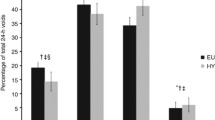Abstract
Studies have shown that the urothelium has a transport function and that urine composition changes on its way through the urinary tract. In this study, we investigated the hypothesis that the composition of voided urine differs from and does not reflect that of the renal pelvis. Urine samples were obtained from the renal pelvis and voided urine of 18 healthy volunteers (mean age 36.2 ± 5.1 SD years, 10 men, 8 women). The pH was determined using a pH electrode, osmolality by means of micro-osmometry and Na and K using flame photometry. In comparison to the urine of the renal pelvis, voided urine showed significant increases in pH, osmolality and Na and K concentrations (P < 0.05 for each). There were no significant differences in gender and age. This study has demonstrated that the pH, osmolality, Na and K of voided urine differ significantly from the values in the renal pelvis. Urine composition is thus modified as it passes through the urinary tract, which would support the concept of a dynamic urothelium. The composition of voided urine does not seem to compare to renal pelvic urine. This concept needs to be considered in urine analysis evaluation and its relation to renal function.
Similar content being viewed by others
References
Lewis SA (2000) Everything you wanted to know about the bladder epithelium but were afraid to ask. Am J Physiol Renal Physiol 278:867–872
Hurst RE, Roy JB, Parsons CL (1997) The role of glycosaminoglycans in normal bladder physiology and the pathophysiology of interstitial cystitis (Chapter 11). In: Sant GR (ed) Interstitial cystitis. Lippincott-Raven, Philadelphia, pp 93–100
Hohlbrugger G (1995) The vesical blood–urine barrier: a relevant and dynamic interface between renal function and nervous bladder composition. J Urol 154:6–15
Ferguson DR (1999) Urothelial function. BJU Int 84:235–242
Cahill DJ, Fry CH, Foxall PJD (2003) Variation in urine composition in the human urinary tract: evidence of urothelial function in situ. J Urol 169:871–874
Wickham JEA (1964) Active transport of sodium ion by mammalian bladder epithelium. Invest Urol 2:145–149
Shafik A, El-Sibai O, Shafik AA, Ahmed I (2004) Do vesical and voided urine have identical composition? Scand J Urol Nephrol 38:243–246
Shafik A, Shafik IA, El-Sibai O, Shafik AA (2005) Changes in the urine composition during its passage through the ureter. A concept of urothelial function. Urol Res 33:426–428
Levinsky NG, Berliner RW (1959) Changes in composition of the urine in ureter and bladder at low urine flow. Am J Physiol 196:549–553
Schmidt-Nielsen B (1977) Excretion in mammals: role of the renal pelvis in the modification of the urinary concentration and composition. Fed Proc 36:2493–2503
Pitts RF, Ayers JL, Scheiss WA (1948) The renal regulation of acid–base balance in man. III. The reabsorption and excretion of bicarbonate. J Clin Invest 28:35–39
Robertson W, Peacock M, Nordin B (1968) Saturation inhibition index as a measure of the risk of calcium oxalate stone formation in the urinary tract. N Engl J Med 34:579–583
Janqueira LC, Carneiro J, Long JA (1986) Urinary system. In: Janqueira LC, Carneira J, Long JA (eds) Basic histology, 5th edn. Lange Medical Publications, Los Altos, pp 413–414
Shafik A, Moftah A, El-Sibai O, Mohi-El-Din M, El-Sayed A (1990) Testicular veins: anatomy and role in varicocelogenesis and other pathologic conditions. Urology 35:175–182
Acknowledgment
Margot Yehia assisted in preparing the manuscript.
Author information
Authors and Affiliations
Corresponding author
Rights and permissions
About this article
Cite this article
Shafik, A., Ahmed, I., El Sibai, O. et al. Does the composition of voided urine reflect that of the renal pelvis?. Urol Res 34, 261–264 (2006). https://doi.org/10.1007/s00240-006-0058-0
Received:
Accepted:
Published:
Issue Date:
DOI: https://doi.org/10.1007/s00240-006-0058-0




